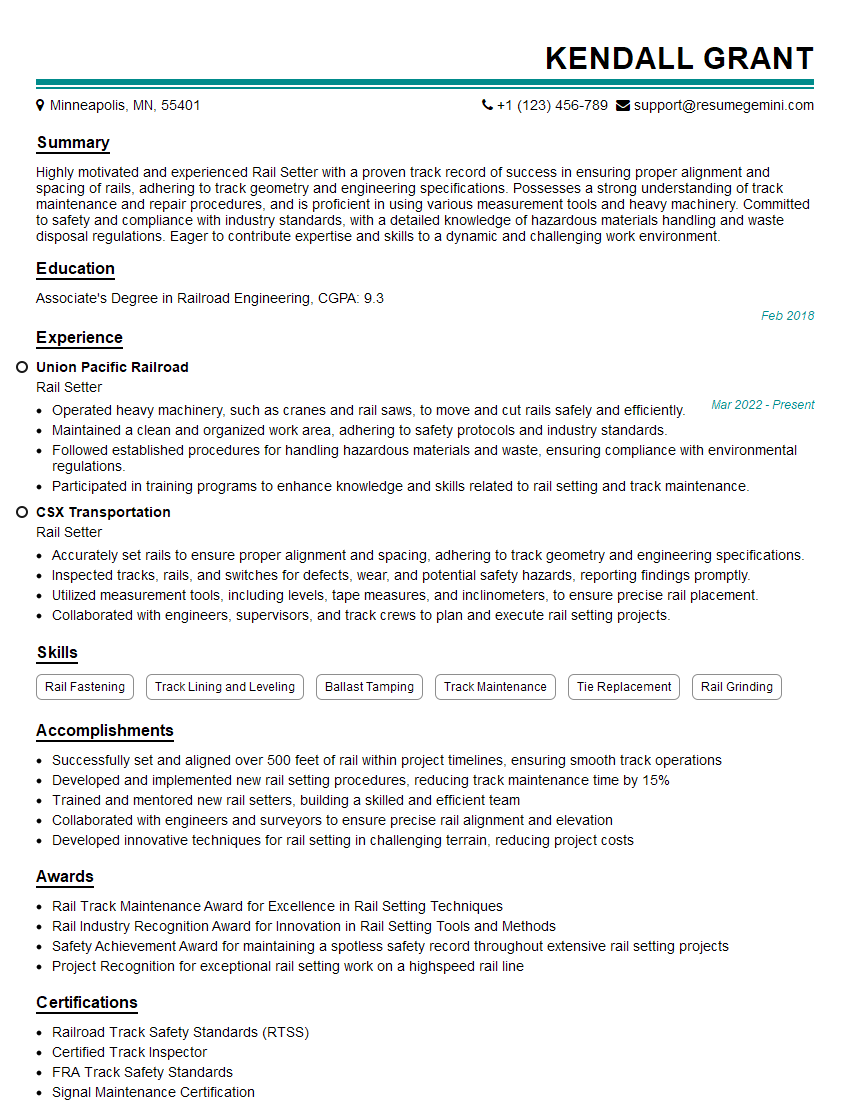Are you a seasoned Rail Setter seeking a new career path? Discover our professionally built Rail Setter Resume Template. This time-saving tool provides a solid foundation for your job search. Simply click “Edit Resume” to customize it with your unique experiences and achievements. Customize fonts and colors to match your personal style and increase your chances of landing your dream job. Explore more Resume Templates for additional options.

Kendall Grant
Rail Setter
Summary
Highly motivated and experienced Rail Setter with a proven track record of success in ensuring proper alignment and spacing of rails, adhering to track geometry and engineering specifications. Possesses a strong understanding of track maintenance and repair procedures, and is proficient in using various measurement tools and heavy machinery. Committed to safety and compliance with industry standards, with a detailed knowledge of hazardous materials handling and waste disposal regulations. Eager to contribute expertise and skills to a dynamic and challenging work environment.
Education
Associate’s Degree in Railroad Engineering
February 2018
Skills
- Rail Fastening
- Track Lining and Leveling
- Ballast Tamping
- Track Maintenance
- Tie Replacement
- Rail Grinding
Work Experience
Rail Setter
- Operated heavy machinery, such as cranes and rail saws, to move and cut rails safely and efficiently.
- Maintained a clean and organized work area, adhering to safety protocols and industry standards.
- Followed established procedures for handling hazardous materials and waste, ensuring compliance with environmental regulations.
- Participated in training programs to enhance knowledge and skills related to rail setting and track maintenance.
Rail Setter
- Accurately set rails to ensure proper alignment and spacing, adhering to track geometry and engineering specifications.
- Inspected tracks, rails, and switches for defects, wear, and potential safety hazards, reporting findings promptly.
- Utilized measurement tools, including levels, tape measures, and inclinometers, to ensure precise rail placement.
- Collaborated with engineers, supervisors, and track crews to plan and execute rail setting projects.
Accomplishments
- Successfully set and aligned over 500 feet of rail within project timelines, ensuring smooth track operations
- Developed and implemented new rail setting procedures, reducing track maintenance time by 15%
- Trained and mentored new rail setters, building a skilled and efficient team
- Collaborated with engineers and surveyors to ensure precise rail alignment and elevation
- Developed innovative techniques for rail setting in challenging terrain, reducing project costs
Awards
- Rail Track Maintenance Award for Excellence in Rail Setting Techniques
- Rail Industry Recognition Award for Innovation in Rail Setting Tools and Methods
- Safety Achievement Award for maintaining a spotless safety record throughout extensive rail setting projects
- Project Recognition for exceptional rail setting work on a highspeed rail line
Certificates
- Railroad Track Safety Standards (RTSS)
- Certified Track Inspector
- FRA Track Safety Standards
- Signal Maintenance Certification
Career Expert Tips:
- Select the ideal resume template to showcase your professional experience effectively.
- Master the art of resume writing to highlight your unique qualifications and achievements.
- Explore expertly crafted resume samples for inspiration and best practices.
- Build your best resume for free this new year with ResumeGemini. Enjoy exclusive discounts on ATS optimized resume templates.
How To Write Resume For Rail Setter
- Highlight your experience and skills in rail setting, track maintenance, and heavy machinery operation.
- Showcase your knowledge of track geometry and engineering specifications.
- Demonstrate your commitment to safety and compliance by emphasizing your understanding of industry standards and hazardous materials handling.
- Emphasize your ability to work independently and as part of a team, and your willingness to work in various weather conditions.
Essential Experience Highlights for a Strong Rail Setter Resume
- Accurately set and align rails to meet track geometry and engineering specifications.
- Inspect tracks, rails, and switches for defects, wear, and potential hazards, and report findings promptly.
- Use measurement tools, including levels, tape measures, and inclinometers, to ensure precise rail placement.
- Collaborate with engineers, supervisors, and track crews to plan and execute rail setting projects.
- Operate heavy machinery, such as cranes and rail saws, to move and cut rails safely and efficiently.
- Maintain a clean and organized work area, adhering to safety protocols and industry standards.
- Follow established procedures for handling hazardous materials and waste, ensuring compliance with environmental regulations.
Frequently Asked Questions (FAQ’s) For Rail Setter
What are the key responsibilities of a Rail Setter?
The key responsibilities of a Rail Setter include setting and aligning rails, inspecting tracks and switches for defects, using measurement tools to ensure precise placement, and operating heavy machinery to move and cut rails.
What qualifications are required to become a Rail Setter?
To become a Rail Setter, you typically need at least a high school diploma or equivalent, as well as experience in track maintenance or construction. Some employers may prefer candidates with an Associate’s Degree in Railroad Engineering or a related field.
What is the work environment of a Rail Setter like?
Rail Setters typically work outdoors in various weather conditions. They may work on tracks that are active or inactive, and may be required to travel to different locations for projects.
What are the career advancement opportunities for a Rail Setter?
With experience and additional training, Rail Setters can advance to positions such as Track Supervisor, Track Inspector, or Maintenance Supervisor.
What is the average salary of a Rail Setter?
The average salary of a Rail Setter in the United States is around $55,000 per year, according to Salary.com.
What are the benefits of working as a Rail Setter?
Benefits of working as a Rail Setter include job security, opportunities for overtime pay, and the chance to work outdoors.
What are the challenges of working as a Rail Setter?
Challenges of working as a Rail Setter include working in various weather conditions, potential exposure to hazardous materials, and the need to work on active or inactive tracks.